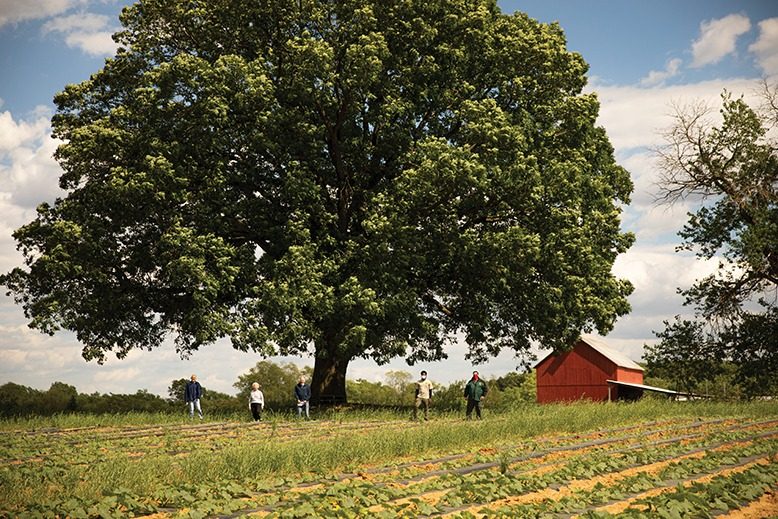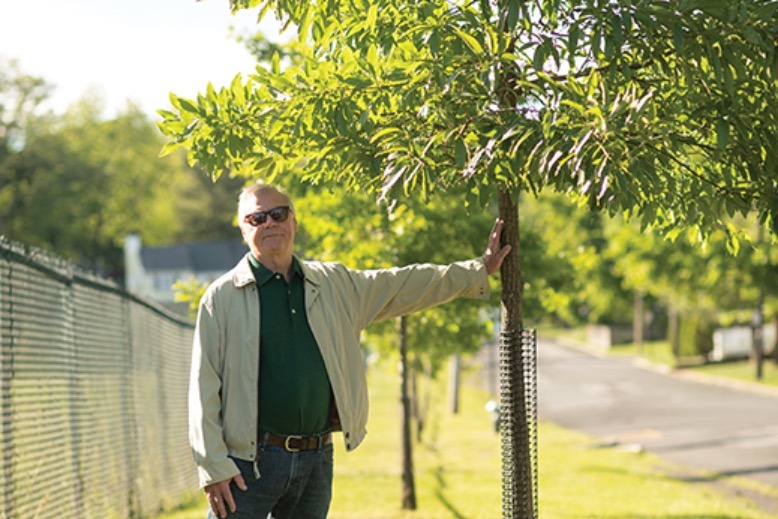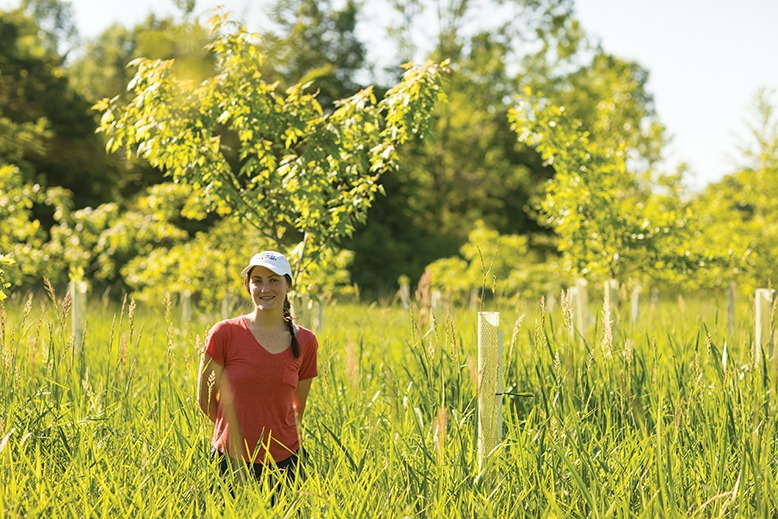
For a 500-year-old oak, it didn’t look a day over 300. Steel cables supported its thick, widespread boughs, regular prunings and feedings kept it healthy, and strategically placed lightning rods protected it from nature’s assault. Still, Joseph Bennett felt compelled to collect buckets of acorns from the most famous tree in the little town of Salem over the course of several sunny fall days two years ago. Eight months later, the massive, ashy-gray trunk of the Salem white oak snapped.
“I never anticipated when I was collecting seed that it would go down less than a year later,” says Bennett, tree coordinator for the New Jersey Forest Service’s Big Tree Conservation Program.
This fall, pending the impact of Covid-19, all 565 New Jersey municipalities will receive a foot-tall white oak sapling grown from those acorns. Planted in the right spot, given space to grow, and protected from severe weather, hungry deer and the latest invasive pests and diseases, these precious twigs could grow more than 100 feet tall, with a wide canopy like their parent.
“It’s not just the number of trees planted,” says Carrie Sargeant, a regional forester who coordinates the state Forest Service’s Urban and Community Forestry Program. “We have to steward our trees. Trees need to grow and live to their full potential to maximize ecological benefits.”
And that’s not just for the sake of the trees. Having trees of many ages, old to young, provides a myriad of benefits to their neighbors—including humans. Younger trees remove carbon rapidly as they grow to maturity. Mature trees store this carbon, which is important in mitigating climate change. Managing trees from planting to maturity is key in capturing all of the ecosystem benefits trees have to offer, such as controlling erosion runoff and flooding; achieving layered canopies that cast more cooling shade; and providing food and shelter for wildlife.
[RELATED: A Quick Guide to Planting Trees in New Jersey]
These days, trees could use a hug. Trees suffer under the weight of extreme weather and overdevelopment, and are often threatened by insect infestations and disease. The last century saw disease clear the state’s forests of American chestnut trees; city streets lost their American elms. Since the late 1960s, periodic outbreaks of the gypsy moth caterpillar have defoliated thousands of acres of forest. Asian long-horned beetles nearly wiped out maple trees before their onslaught was brought under control several years ago. More recently, the southern pine beetle has invaded pine forests in South Jersey. The emerald ash borer continues to kill ash trees in our northern forests, as well as our towns. (Last year, 2,000 ash trees were removed in Montclair when dozens were found to be infected.) Closing in are new threats just beyond our border, including the spotted lanternfly and oak wilt, which threaten our state tree, the northern red oak, already under attack in South Jersey by bacterial leaf scorch.
There is hope. Public and private entities are working to restore lost species and save those under threat. What’s more, New Jersey has a history of preserving our forests, which support 83 tree species, including our state’s most numerous species: red maple, eastern red cedar and sweet birch in the north, and pitch pine, white oak and Atlantic white cedar in the south.
Today, 42 percent of New Jersey is forested, according to the U.S. Forest Service, with some 912 million trees greater than an inch in diameter. That’s more than 100 trees per New Jerseyan. But if the number and diversity of trees in the Garden State is impressive, so too are the people dedicated to restoring, expanding and maintaining the tree canopy in our cities, suburbs and floodplains. Here, we meet three of them.
Maintaining municipal trees
Fifteen years ago, Gene Cracovia decided to learn more about trees. Today, as chair of Madison’s Shade Tree Management Board, Cracovia, along with other board members, keeps count of the number of street trees in his Morris County borough (6,700, give or take), tracks the latest invasive pest (spotted lanternfly) and performs surveys to assess the trees’ pruning and removal needs. “Maintenance is the largest line item in the [management board’s] budget,” he says.
More than half of all New Jersey municipalities, including Madison, participate in the Urban and Community Forestry Program. The program provides grants, technical assistance and training to municipalities with state-approved tree-management plans. Grants are funded through the state’s Treasure Our Trees license plates.
The program arose after many municipalities disbanded their shade-tree commissions, thanks to litigation fears stemming from hazardous tree situations. The 1996 Shade Tree and Community Forestry Assistance Act provides liability protection to municipalities and counties that participate in the program.
Severe weather swings are among the biggest challenges facing municipalities. “We’ll get long dry spells followed by torrential rains that weaken the trees,” says Cracovia. Last October, he recalls, a tornado touched down in Madison, snapping and uprooting trees.

“Though our tree-planting team will not be here 25 to 50 years from now, what we did should still be here,” says Gene Cracovia, with a recent planting on Burnet Road in Madison. Photo by John Bessler
Cracovia credits the borough’s plan with reducing post-storm power outages. “Every time we have a major storm, one of the first things I want to know is, how many trees took down our wires?” he says. “It’s not zero. But it’s less than maybe other towns, because we’re really proactive on any tree that needs maintenance.”
Madison is one of the latest municipalities to pass a tree-protection ordinance requiring a permit to remove a healthy tree of a certain size. But sometimes, trees have to go. Two years ago, the tree-management board limited a potential infestation of the emerald ash borer by removing ash trees lining two streets, which would have become infested, and replacing them with pin, willow and sawtooth oaks, and smaller redbud and serviceberry trees. “We took that approach after the experts told us we would lose them,” says Cracovia.
When not overseeing the ordering and planting of more than 100 trees every year, Cracovia serves as treasurer of Friends of Madison Shade Trees, Inc., which augments the board by raising money and planting trees. “If you can get a nonprofit that complements and works with official boards, you can get more done,” he says.
While Covid-19 has delayed plantings and forced the board to meet virtually, Cracovia looks to the future down a tree-lined road. “It takes many people working together to maintain our tree canopy, and the trees we plant today will become the tree canopy of tomorrow. Though Madison’s tree-planting team will not be here 25 to 50 years from now, what we did should still be here.”
Made in the urban shade
Young dogwoods, silver lindens, American elms and black oaks were on order. Pre-dug tree pits lined the sidewalks of Fourth and Washington Park in Lanning Square, Camden. Volunteers signed up from the Lanning Square West Residents Association Cooper’s Ferry Partnership. Then social distancing orders pushed the April tree-planting event to fall and may have to exclude volunteers due to Covid-19.
None of this diminished Meredith Brown’s goal of creating tree equity in underserved urban neighborhoods. “Every community has a right to healthy street trees,” says Brown, program coordinator for the New Jersey Tree Foundation’s Urban Airshed Reforestation Program, which has planted more than 7,200 trees in Camden and Gloucester City since 2002. Its separate Renaissance Tree Program operates in Newark and Trenton. Funding for the programs comes from grants from the William Penn Foundation, the MKM Foundation and other charitable groups.
Among other benefits, urban trees cool increasingly hot cities and can decrease stormwater runoff, says Brown. “Flooding is an issue in Camden. Its sewer system becomes overwhelmed when there’s a lot of rain. The trees will absorb a good chunk of that runoff rather than it flooding homes.” Some of the tree pits were specially designed and enhanced to capture additional stormwater to address Camden’s flooding.
[RELATED: The Can-Do Spirit of New Jersey’s Citizen Scientists]
Before a tree is planted in front of a home, its residents must agree to water, mulch and prune it, and keep the area around the tree trash-free. In return, they receive maintenance instructions and are invited to attend a free, annual, in-depth TreeKeepers workshop.
Brown selects a variety of trees to ensure plenty of shade, color and long-term health. “By planting a mix, if some disease wipes out the dogwoods, we’ll still have the three other species,” she says.
In addition to growing trees, the program grows a sense of community. “It brings people out of their homes and gets them to engage with their neighbors,” she says, noting that it draws repeat volunteers year after year.
Despite the pandemic, Brown’s enthusiasm remains undiminished. “I love planting trees and working with the residents,” she says. “You get to work together and see what their vision is, then you come in and transform a block with trees.”
Reforesting riverbanks
It’s early spring, and Michelle DiBlasio is driving along the back roads of Paulins Kill, a 40-mile river that meanders through Sussex and Warren counties before emptying into the Delaware River. She pulls over at a section of stream where buds of silver maple and furry catkins of black willow peek out from 5-foot-tall white protective tubes. Nestled inside more tubes are river birch, pin oaks, American sycamore and red maples, along with shrubs like silky dogwood, serviceberry and buttonbush.
Five years ago, the view was a straight shot to the crumbling riverbank over thick stands of invasive reed canary grass planted for cows by dairy farmers long ago. “You might have tree saplings trying to come up, but the canary grass is super-competitive. The trees never had a chance,” says DiBlasio, watershed-restoration coordinator for the New Jersey field office of the Nature Conservancy in Chester.
Today, the more than 57,000 trees planted along 9.5 miles of river have a good chance, thanks to the Nature Conservancy’s Roots for Rivers project, which started five years ago with the Paulins Kill restoration. In 2018, the Nature Conservancy teamed with the Watershed Institute in Pennington and Sustainable Jersey in Ewing to administer small grants to help municipalities, nonprofits, government entities and school districts implement their own planting projects on riverside lands.
Some 79 sites later, with more plantings planned into fall, the project ends this year (unless delays from Covid-19 extend it), having exceeded its goal of planting 100,000 trees throughout New Jersey, from Kingswood Township Park to Troy Meadows Wetlands in Parsippany to the wetlands along the Maurice River in Vineland.

Michelle DiBlasio, a watershed restoration coordinator for the Nature Conservancy in Chester, strolls through a field of saplings growing inside plastic tubes that protect them from grazing deer and the surrounding invasive grasses. Photo by John Bessler
Reforesting floodplains around riverbanks is one step to revitalizing New Jersey rivers, 85 percent of which are considered impaired, according to the Nature Conservancy. Trees prevent riverbanks from eroding, provide canopy to keep water temperatures optimal for fish and other aquatic life, and prevent flooding by absorbing runoff from heavy storms.
With plantings mostly completed, the work moves to maintenance. Stakes and tubes must be collected and tree health assessed. “We need to aim for a goal of at least an 85 percent survival rate,” says DiBlasio. “If not, we can go back and replant.”
Now when DiBlasio looks to Paulins Kill, she envisions a healthy and protected ecosystem for both wildlife and people to enjoy, thanks to the conservation efforts made by a team of dedicated stakeholders, as well as the state’s upgraded C1 protected-stream designation.
“We still have a long road ahead taking care of the trees,” she says. “But you start to see the day when you’ll be able to climb some of those trees, and the shade will reach over the river.”
